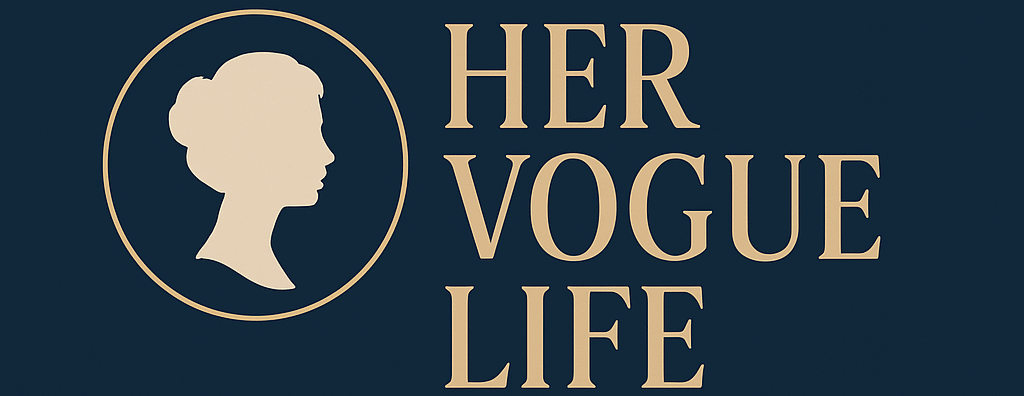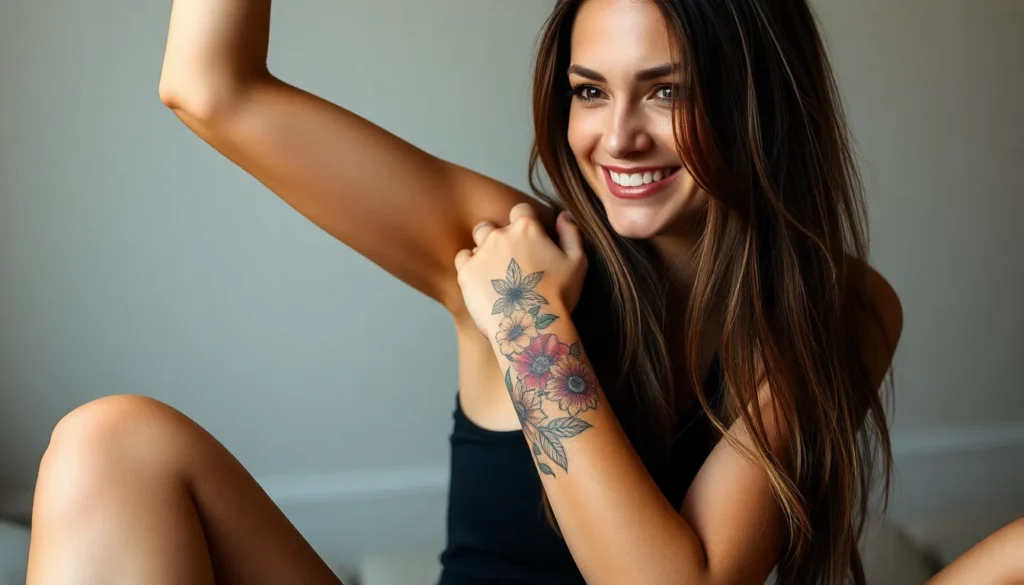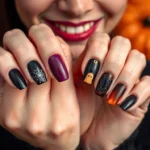Your arms offer some of the most versatile and stunning canvas options for tattoo artistry. Whether you’re planning your first ink or adding to your collection, choosing the perfect arm placement can make or break your tattoo’s visual impact and personal significance.
We’ve seen countless women transform their arms into breathtaking works of art through strategic placement decisions. From delicate wrist designs that peek out subtly to bold shoulder pieces that command attention, your arm’s unique anatomy provides endless creative possibilities. The key lies in understanding how different placements complement your lifestyle, profession, and personal style.
Today’s tattoo trends favor everything from minimalist forearm scripts to elaborate sleeve compositions that flow seamlessly around your arm’s natural curves. We’ll explore the most popular and practical arm placement options that’ll help you make an well-informed choice about your next tattoo investment.
Upper Arm Placement: The Classic Canvas for Bold Designs
The upper arm offers the most versatile real estate for women’s tattoo designs, providing ample space for both detailed artwork and meaningful symbolism. This prime location allows for easy concealment when needed while offering stunning visibility when desired.
Shoulder Cap Tattoos for Maximum Visibility
Shoulder cap tattoos create an instant focal point that draws attention to your upper body silhouette. We recommend this placement for women who want their ink to make a statement, as the rounded shoulder area naturally frames geometric patterns, florals, and mandala designs.
The shoulder cap accommodates various tattoo sizes, from small delicate pieces measuring 3-4 inches to larger compositions spanning 6-8 inches across. Popular designs include sunflowers, compass roses, and ornate jewelry motifs that complement the natural curve of your shoulder.
Professional tattoo artists often suggest this placement for first-time clients because the shoulder cap experiences minimal stretching over time. The skin here remains relatively stable, ensuring your tattoo maintains its crisp lines and vibrant colors for years to come.
Bicep Wraps That Flow With Your Natural Curves
Bicep wrap tattoos follow the cylindrical shape of your upper arm, creating a seamless design that appears to flow around your muscle. These tattoos work exceptionally well for nature-inspired themes like vine patterns, snake designs, or tribal bands that emphasize the arm’s natural contours.
We’ve observed that bicep wraps measuring 4-6 inches in height provide the perfect balance between visibility and proportion. The placement allows for easy showcasing in sleeveless tops while remaining completely hidden under professional attire.
Floral wraps featuring roses, peonies, or cherry blossoms rank among the most requested bicep designs for women. These organic patterns complement the arm’s natural movement and create stunning visual impact during everyday activities.
Half Sleeve Options for Gradual Commitment
Half sleeves extending from shoulder to elbow offer an excellent introduction to larger tattoo projects without the full commitment of a complete sleeve. This placement provides approximately 80-100 square inches of canvas space, allowing for complex storytelling through interconnected design elements.
Many women choose half sleeves as their second or third major tattoo, building upon smaller pieces they already have. The gradual approach allows you to work with your tattoo artist over multiple sessions, typically requiring 3-5 appointments spaced 4-6 weeks apart.
We recommend half sleeves for women who want to explore themes like botanical gardens, celestial maps, or personal journey narratives. The extended canvas allows for intricate shading, color gradients, and detailed line work that simply isn’t possible with smaller tattoo placements.
Forearm Placement: Showcasing Your Art in Plain Sight
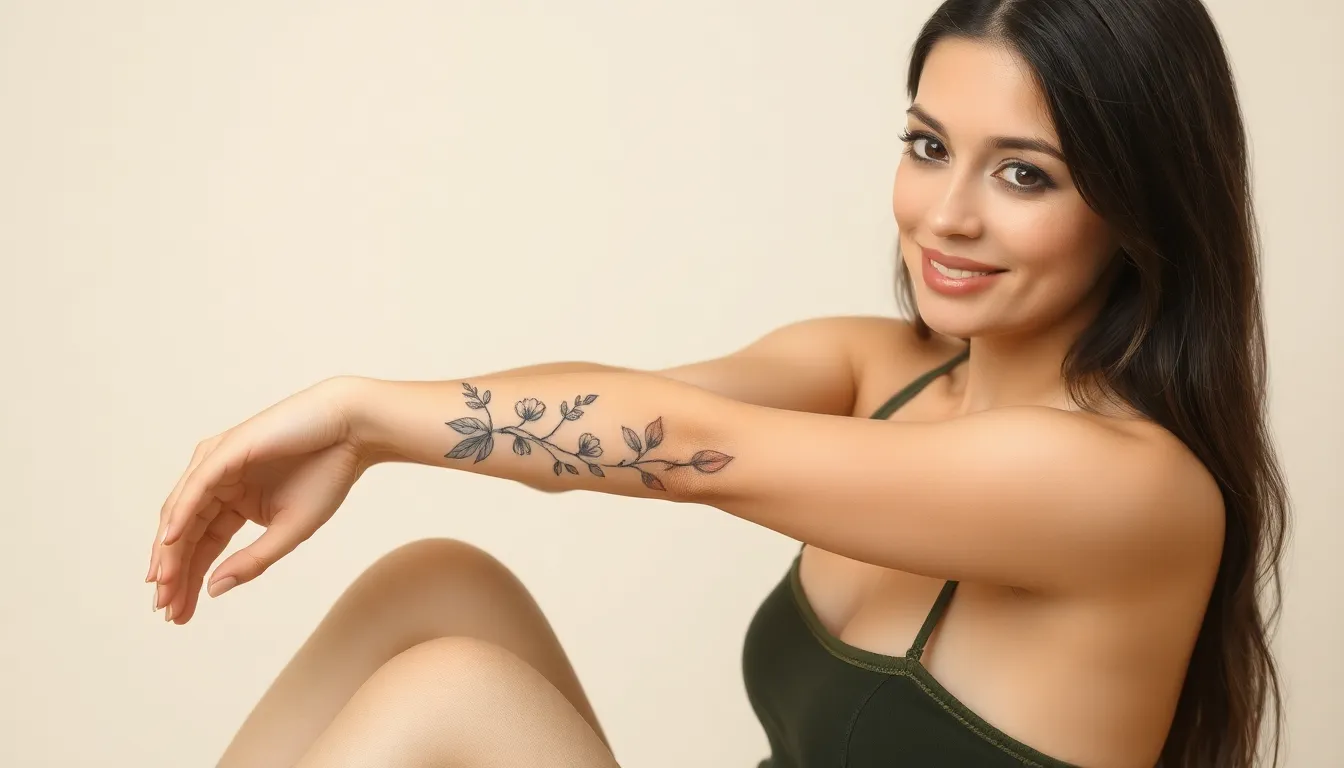
Forearm tattoos offer unmatched versatility for women seeking both visibility and flexibility in their body art. We’ve found this placement provides a larger canvas compared to other arm areas, making it perfect for everything from intricate artwork to minimalist designs that can be easily displayed or concealed under sleeves.
Inner Forearm for Personal and Intimate Designs
Private positioning makes the inner forearm ideal for deeply personal tattoo artwork. We recommend this discreet location for meaningful elements like names, important dates, or delicate symbols that hold special importance. Subtle storytelling flourishes here since this area remains less exposed than the outer forearm while still allowing visibility when desired.
Script tattoos particularly shine on the inner forearm’s smooth surface. Fine line art creates stunning results in this intimate space, with many women choosing small meaningful motifs that speak to their personal journey. Delicate designs work exceptionally well here, from minimalist quotes to intricate mandala details that can be shared selectively.
Outer Forearm for Statement Pieces and Bold Graphics
Maximum visibility defines the outer forearm as the prime real estate for eye-catching tattoo designs. We see this placement chosen frequently for larger, more elaborate artwork that demands attention and showcases artistic creativity. Bold graphics thrive in this highly visible location, from traditional tattoo styles to vibrant watercolor compositions.
Statement pieces find their perfect home on the outer forearm’s expansive surface. Nature inspired imagery creates breathtaking results here, with detailed illustrations and geometric patterns accommodating various artistic styles. Creative expression reaches new heights through this placement, allowing artists to showcase intricate work that flows beautifully with the arm’s natural contours.
Wrist-to-Elbow Coverage for Seamless Storytelling
Extended canvas potential transforms the wrist to elbow area into a masterpiece of connected artistry. We’ve observed how this coverage allows for multi element designs that create cohesive narratives flowing along the entire forearm length. Sleeve tattoos develop naturally in this space, with sequenced imagery that tells complete stories through interconnected elements.
Flexible orientation options include vertical, horizontal, or wrap around designs that maximize the forearm’s storytelling potential. Both subtle and expansive compositions work beautifully here, with the ability to scale designs perfectly to fit the arm’s natural contours. Future additions integrate seamlessly into wrist to elbow coverage, making this placement ideal for women planning to expand their tattoo collections over time.
Delicate Wrist Placements: Small Tattoos With Big Impact
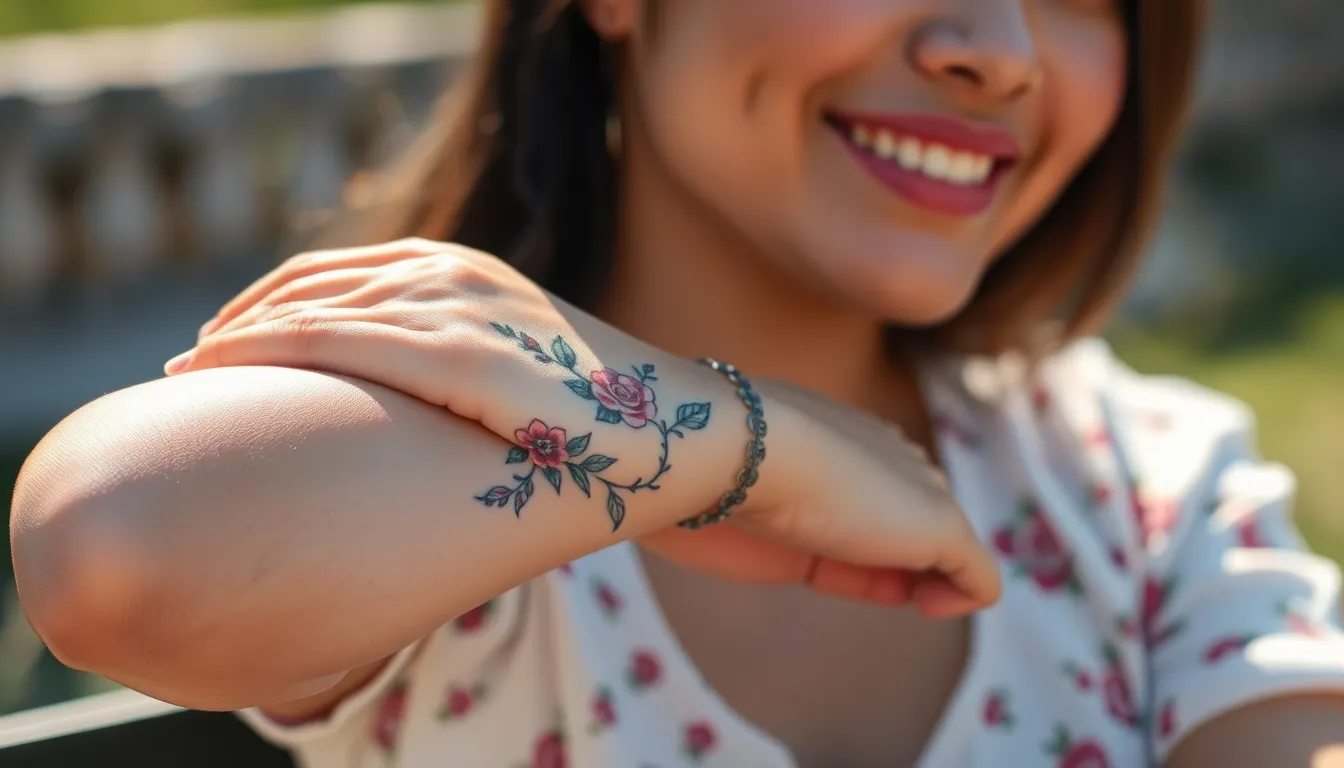
Wrist tattoos offer maximum impact even though their compact size. These intimate placements combine personal significance with artistic expression in ways that larger tattoos simply can’t match.
Inner Wrist for Meaningful Symbols and Text
Inner wrist tattoos create the perfect canvas for personal and intimate designs that hold deep meaning. This placement naturally draws the eye inward, making it ideal for inspirational quotes, names, and small symbols that serve as daily reminders of what matters most.
Small words work exceptionally well in this area, allowing for delicate script that flows with the wrist’s natural contours. Initials of loved ones find their perfect home here, creating subtle yet powerful connections to the people who matter most. Meaningful symbols like hearts, infinity signs, or spiritual icons thrive in this protected space where they remain visible to you while maintaining privacy from others.
The inner wrist’s reduced sun exposure helps preserve vibrant colors and crisp lines over time. This placement also offers the flexibility to conceal your tattoo when needed, simply by rotating your wrist or wearing a watch or bracelet.
Outer Wrist for Decorative Bands and Bracelets
Outer wrist placements shine when showcasing decorative bands and bracelet inspired designs that wrap around the wrist like permanent jewelry. These tattoos create stunning visual impact while maintaining the delicate aesthetic that makes wrist tattoos so appealing.
Bracelet style tattoos work beautifully in this location, mimicking the look of fine jewelry with intricate patterns and flowing lines. Decorative bands can incorporate geometric patterns, floral motifs, or cultural designs that celebrate your heritage or personal style. Chain link patterns create the illusion of wearing permanent jewelry, while delicate floral vines add natural beauty that complements the wrist’s graceful lines.
This placement offers excellent visibility for showcasing your artistic choices while remaining small enough to maintain professional appropriateness. The outer wrist’s position makes it perfect for designs that benefit from being viewed from multiple angles as your hands move throughout the day.
Side Wrist for Vertical Designs and Dates
Side wrist tattoos excel at accommodating vertical designs and dates that flow naturally with the arm’s elongated shape. This unique placement allows for creative compositions that wouldn’t work as effectively in other locations.
Vertical designs find their perfect match in the side wrist’s natural orientation, creating harmonious artwork that enhances rather than fights against the body’s natural lines. Dates hold special significance in this placement, whether commemorating birthdays, anniversaries, or milestone moments that deserve permanent recognition. Roman numerals work particularly well here, adding classical elegance to important dates.
Single word tattoos positioned vertically create striking visual impact while maintaining the delicate aesthetic that makes wrist tattoos so popular. This placement also accommodates small symbols or icons that benefit from the vertical orientation, such as arrows, feathers, or minimalist botanical elements.
The side wrist’s position offers natural protection from daily wear while remaining easily visible when you want to share your meaningful artwork with others.
Shoulder Blade Extensions: Connecting Arm to Back Art
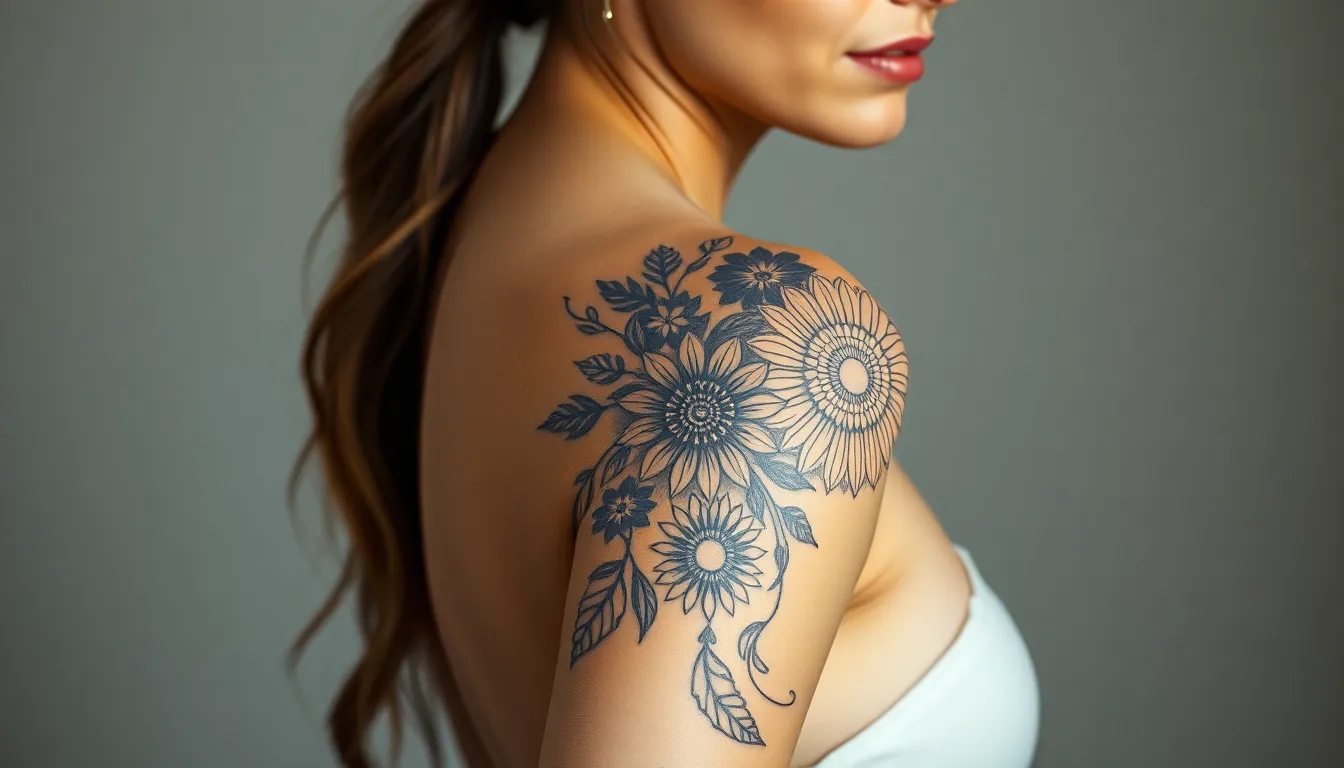
Shoulder blade extensions create stunning visual bridges between arm tattoos and back art, offering one of the most dramatic canvases for women’s tattoo placement. These placements transform individual pieces into cohesive masterpieces that flow naturally with your body’s contours.
Shoulder-to-Shoulder Blade Flow for Large Compositions
Large scale tattoos spanning across both shoulders create striking visual impact through symmetrical flow onto the shoulder blades. We’ve seen expansive artwork featuring detailed mandalas, floral designs, and tribal motifs that tell complete stories across this generous canvas. Symmetrical compositions enhance your natural body contours while allowing for bold, impactful pieces that command attention.
Complex integrated compositions move naturally with your body’s movement, creating ever-changing art that shifts and flows as you walk. Artists can develop intricate patterns that complement your shoulder’s natural curves while extending seamlessly onto the blade area. This placement offers the perfect opportunity for storytelling through interconnected designs that span multiple body areas.
Rear Deltoid Placement for Hidden Surprises
Rear deltoid tattoos offer the perfect “hidden surprise” placement that only you and those closest to you will see. This discreet location carries intimate significance while remaining completely concealed under most clothing styles. We recommend this spot for personal symbols, meaningful dates, or artwork that holds special emotional value.
Circular designs like mandalas and starbursts work exceptionally well here due to the muscle’s natural curvature. Radial patterns complement the rear deltoid’s rounded shape, creating harmonious artwork that follows your body’s natural lines. Artists can use this curved canvas to create dimensional effects that enhance the tattoo’s visual depth.
Shoulder Wrap Designs That Enhance Your Silhouette
Shoulder wrap tattoos accentuate your natural silhouette by following the arm and shoulder’s flowing lines. These designs can extend from your upper arm around the shoulder, sometimes connecting to chest, back, or additional arm tattoos for cohesive compositions. We’ve observed how well floral motifs, geometric patterns, and abstract art work in this placement.
Movement and form become enhanced through carefully planned shoulder wraps that emphasize your body’s natural curves. Artists design these pieces to complement your shoulder’s shape while creating visual interest from multiple angles. Popular choices include botanical designs that seem to grow organically around your shoulder, creating the illusion of living art that moves with your body.
Elbow and Joint Considerations: Working With Natural Movement
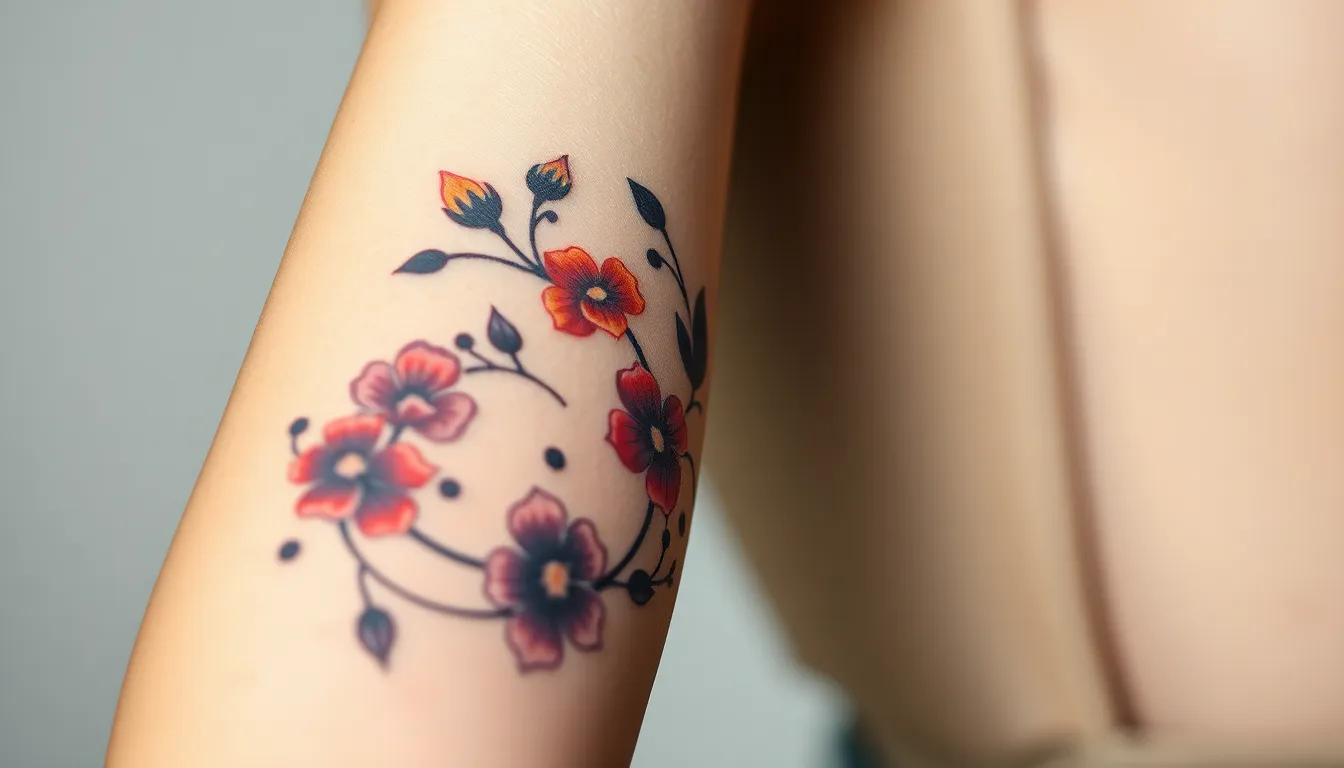
Moving into joint areas requires careful consideration of how our bodies naturally bend and flex. We’ll explore the unique challenges and creative opportunities that elbows present for tattoo placement.
Elbow Ditch Challenges and Creative Answers
Tattooing the elbow ditch presents unique technical and healing challenges that require experienced artists and specialized approaches. The curved nature of this area creates an ideal canvas for radial designs like mandalas and flowers, which naturally complement the body’s contours. Pain levels tend to be higher in this location due to nerve proximity and thin skin coverage.
Healing time extends significantly because of constant bending and friction from daily activities. Stencil placement becomes crucial since the design must remain visually appealing when the joint moves through different positions. Artists often recommend scheduling longer sessions to accommodate the complex curves and ensure proper ink saturation.
Creative answers include using flexible design elements that can accommodate skin movement without losing their visual impact. Experienced tattoo artists suggest avoiding rigid geometric patterns that might distort with joint flexion. Instead, they recommend organic shapes that flow with the natural contours of the elbow area.
Joint Flexibility and Tattoo Longevity
Elbow tattoos face accelerated fading due to the constant stretching and compression of skin during arm movement. Regular bending creates friction that can cause ink to fade faster than tattoos placed on more stable areas. Proper aftercare becomes essential for maintaining color vibrancy and line integrity over time.
Strategic ink selection helps combat movement related wear by choosing pigments and techniques specifically designed for high mobility areas. Artists often apply slightly thicker line work to account for natural spreading that occurs with joint movement. Touch up sessions may be needed more frequently compared to other arm placements.
Longevity improves with careful design planning that accounts for how skin moves and stretches around the joint. Designs that work with rather than against natural movement patterns tend to age more gracefully. Quality aftercare products and sun protection become even more critical for maintaining the tattoo’s appearance.
Movement Friendly Design Adaptations
Circular and organic motifs work best around elbow joints since they naturally conform to the area’s curved movement patterns. Rigid straight lines and fine details near folding points tend to distort and lose definition over time. Artists recommend using softer line work that can flex with the skin’s natural elasticity.
Rounded patterns and flowing elements create visual harmony that remains appealing regardless of arm position. Nature inspired themes like vines, flowers, and water elements adapt well to joint movement. These designs maintain their aesthetic appeal whether the arm is extended or bent.
Strategic placement of detailed elements away from the joint’s primary flex points helps preserve intricate work. Artists often position fine details on the upper or lower portions of the design while keeping bolder, simpler elements at the joint itself. This approach ensures the tattoo remains cohesive while accounting for natural skin movement.
Full Sleeve Progression: Building Your Arm Masterpiece
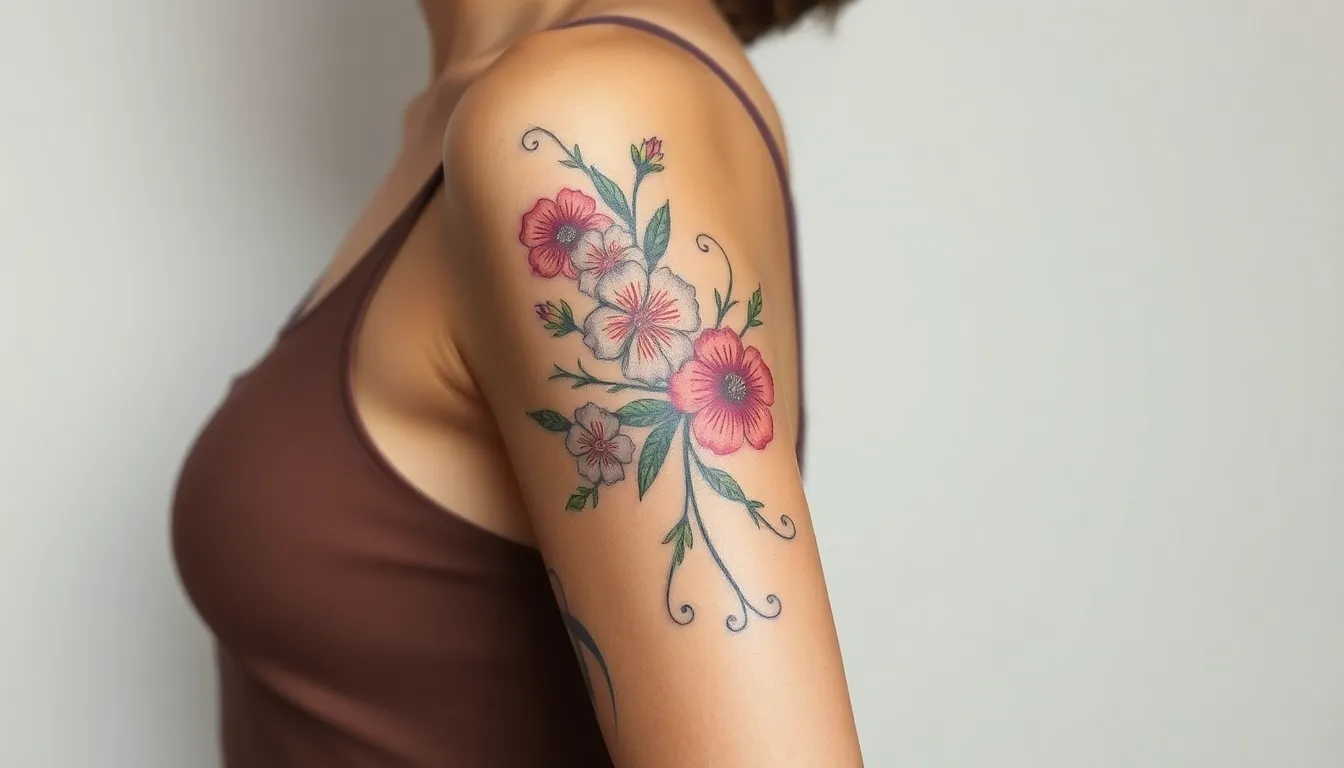
Creating a full sleeve tattoo represents the ultimate commitment to arm artistry, transforming your entire arm into a cohesive canvas. We’ll explore how to strategically build toward this ambitious goal through careful progression and thoughtful planning.
Quarter Sleeve Starting Points for Beginners
Starting with a quarter sleeve offers the perfect introduction to larger tattoo commitments without overwhelming first-time collectors.
Covering from shoulder to midway down the upper arm, this placement provides ample space for single flowers, meaningful initials, or inspirational symbols that won’t intimidate newcomers.
Testing your pain tolerance becomes manageable when you choose the upper arm area, which typically experiences less discomfort than more sensitive locations.
Building confidence happens naturally as you experience the tattoo process on a smaller scale before committing to extensive artwork.
Choosing between upper arm or lower forearm placements allows you to experiment with visibility preferences and professional requirements.
Exploring different artistic styles becomes feasible when working within the contained space of a quarter sleeve design.
Half Sleeve Development and Theme Integration
Extending from upper arm to elbow creates the ideal canvas for developing more complex artistic narratives through interconnected designs.
Combining several motifs successfully requires careful consideration of how floral clusters, wildlife elements, or meaningful quotes will flow together harmoniously.
Achieving visual unity depends on selecting complementary colors and consistent artistic styles that create cohesive storytelling throughout the half sleeve.
Planning symmetry and flow becomes crucial when integrating different design elements within the limited yet versatile space of a half sleeve.
Developing themes gradually allows you to expand your initial quarter sleeve into a more comprehensive artistic statement over multiple sessions.
Working with natural arm contours ensures your half sleeve design enhances rather than fights against your body’s anatomy.
Full Sleeve Planning and Artist Collaboration
Outlining desired themes, styles, and color schemes forms the foundation of successful full sleeve development through comprehensive pre-planning sessions.
Collaborating with experienced tattoo artists ensures your vision translates into custom sketches that perfectly complement your arm’s unique anatomy and proportions.
Spacing sessions strategically allows proper healing time while gradually building your sleeve from shoulder to wrist over multiple appointments.
Creating cohesive visual flow requires mapping out how each piece will complement the next, resulting in a unified masterpiece rather than disconnected elements.
Choosing between nature motifs, mandalas, floral patterns, or abstract artwork depends on your personal story and the artistic narrative you want your arm to tell.
Planning your investment wisely involves understanding that full sleeves represent important time and financial commitments that develop over months or years.
Pain Level Considerations: What to Expect in Each Placement
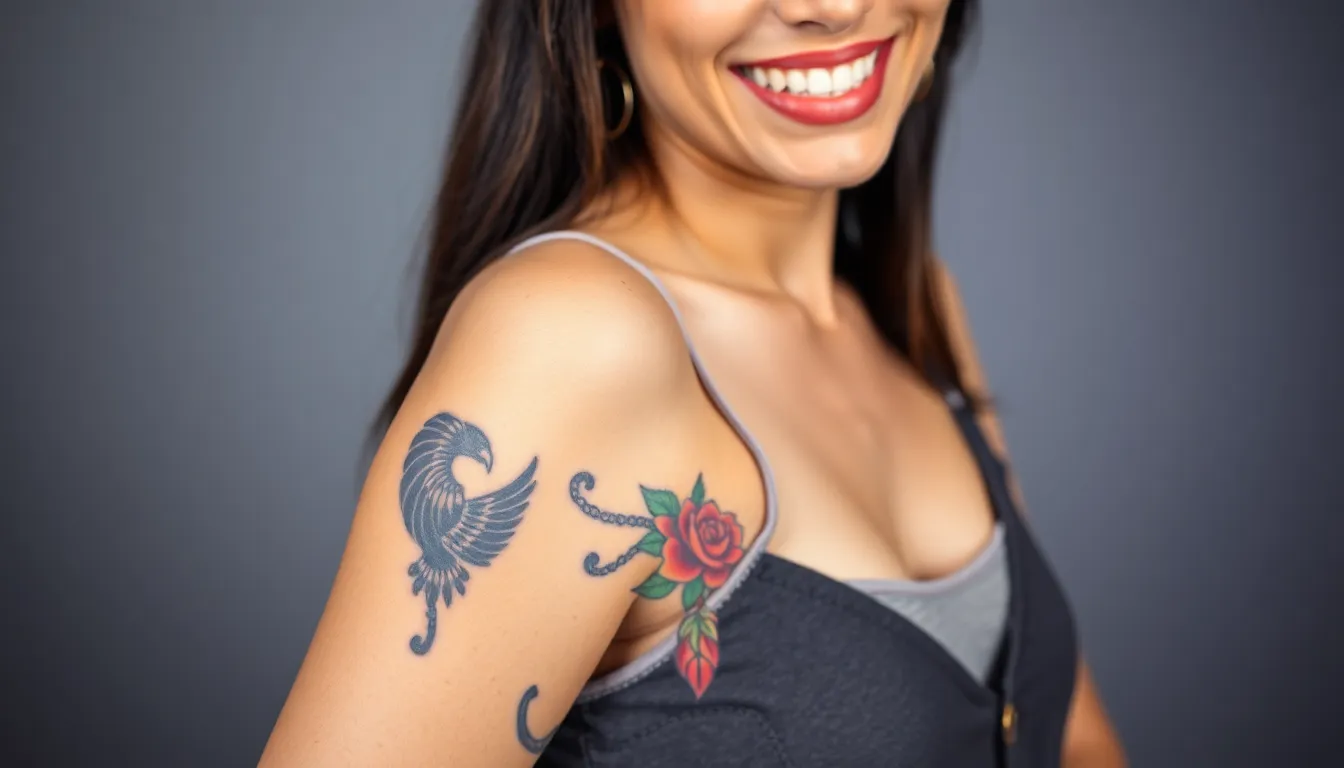
Understanding pain levels across different arm placements helps you make informed decisions about your tattoo journey. Each area of the arm presents unique challenges and comfort levels based on muscle density, nerve distribution, and proximity to bone structures.
Most Comfortable Arm Locations for First-Time Clients
Outer bicep placements rank among the most comfortable options for newcomers to tattooing. This area benefits from substantial muscle cushioning that acts as a natural buffer between the needle and underlying bone structures. First-time clients consistently report manageable discomfort levels here, making it an ideal starting point for building tattoo confidence.
Forearm positioning offers another excellent entry point for beginners seeking a balance of comfort and visibility. The thick skin and muscle density in this region provide adequate protection from intense sensations. We’ve observed that clients can typically handle longer sessions in forearm areas without important discomfort.
Upper arm locations present the most forgiving experience for those new to tattooing. The generous muscle mass and distance from major nerve clusters create optimal conditions for comfortable tattoo sessions. Many artists recommend starting here because clients can focus on the artistic process rather than managing pain.
Higher Sensitivity Areas and Pain Management
Inner bicep regions contain concentrated nerve endings that amplify sensation during tattooing sessions. The thinner skin and proximity to sensitive nerve pathways make this area particularly challenging for pain-sensitive individuals. Sessions in this location often require more frequent breaks and careful pain management strategies.
Elbow and joint-adjacent areas present the highest pain levels due to minimal flesh coverage over bone structures. The constant movement and stretching of skin in these regions intensify discomfort during both tattooing and healing phases. Artists often recommend shorter sessions and strategic scheduling for these challenging placements.
Breaking tattoo sessions into manageable timeframes helps control discomfort in sensitive areas. Circular designs around the elbow complement natural arm curvature while potentially reducing pain by following the body’s natural contours. Individual pain tolerance varies significantly, so communicating with your artist about comfort levels ensures the best possible experience.
Healing Time Variations by Placement
| Placement | Healing Duration | Complications Risk | Special Care Requirements |
|---|---|---|---|
| Upper Arm | 2-3 weeks | Low | Standard aftercare |
| Forearm | 2-4 weeks | Low to moderate | Protect from sun exposure |
| Inner Arm | 3-5 weeks | Moderate | Minimize friction |
| Elbow | 4-6 weeks | High | Extra movement precautions |
Muscle-dense areas like the upper arm and forearm heal more efficiently due to better blood circulation and thicker skin layers. These locations experience fewer complications and require standard aftercare protocols. The robust tissue structure supports faster cell regeneration and ink settling.
Inner arm tattoos typically extend healing time due to frequent skin friction from daily arm movement. The thinner skin in these areas makes them more susceptible to irritation and requires careful attention to clothing choices during recovery. Moisture management becomes crucial in these naturally warm areas.
Joint-adjacent placements demand the longest healing periods because constant movement stresses the healing skin. Elbow tattoos face particular challenges as the skin stretches and contracts throughout daily activities. Extra care prevents ink displacement and ensures proper healing without compromising the final appearance.
Professional and Social Considerations: Choosing Visibility Wisely

Balancing personal expression with professional expectations requires strategic placement choices that can adapt to different environments. Smart tattoo placement allows you to showcase your art when appropriate while maintaining career flexibility.
Workplace-Friendly Placement Options
Upper arm placement near the shoulder offers the perfect compromise between meaningful design space and professional discretion. This location accommodates larger, detailed artwork while remaining completely hidden under standard business attire or casual shirts with sleeves. Shoulder tattoos symbolize strength and resilience, making them particularly meaningful for women while staying invisible during important meetings or formal presentations.
Inner arm locations provide intimate placement that stays private in most professional settings. These spots work beautifully for personal symbols, meaningful quotes, or memorial pieces that you want to keep close to your heart. The inner upper arm rarely shows even in short sleeve tops, giving you complete control over when to reveal your artwork.
Strategic forearm placement can work in many modern workplaces if you choose smaller, tasteful designs. Simple scripts, delicate florals, or geometric patterns on the lower forearm create subtle artistic touches that don’t overwhelm professional attire. Many contemporary offices now embrace visible tattoos, especially when they’re well executed and appropriately sized.
Easy-to-Conceal Locations for Conservative Environments
Back of the upper arm remains hidden unless you’re wearing completely sleeveless clothing. This placement gives you substantial canvas space for detailed work while ensuring total concealment in traditional professional environments. Banking, law, healthcare, and government positions often require this level of discretion.
Inner arm areas near the elbow stay covered even with short sleeves due to natural arm positioning. These spots work perfectly for meaningful symbols or text that you want to keep private during work hours. The placement allows for creative freedom without compromising your professional image in conservative industries.
Full sleeve options might seem counterintuitive for conservative environments, but they offer complete concealment when covered by clothing. Long sleeves transform bold, comprehensive artwork into completely invisible expressions that only appear during your personal time. This approach works especially well for women in traditional fields who want extensive tattoo work.
Statement Placements for Creative Freedom
Outer arm locations showcase bold designs that make immediate visual impact. These areas highlight floral patterns, portraits, or abstract art that becomes part of your daily presentation. Creative industries, modern tech companies, and artistic fields often celebrate visible tattoos as expressions of individuality and creativity.
Full sleeve tattoos create cohesive artistic statements that span from shoulder to wrist. These comprehensive designs require detailed planning sessions with your artist but deliver maximum visual impact and storytelling potential. Sleeves work particularly well for women in creative careers who want their tattoos to become part of their professional identity.
Elbow and forearm combinations allow for intricate, highly visible artwork that showcases personal stories or symbolic meaning. These placements suit women who work in environments that celebrate self expression, such as creative agencies, galleries, or progressive companies. The visibility becomes part of your personal brand and artistic statement.
Conclusion
We’ve explored the endless possibilities that arm placements offer for women’s tattoo artistry. From the intimate canvas of your inner wrist to the bold statement of a full sleeve, each placement brings its own unique advantages and considerations.
Remember that the best tattoo placement is one that aligns with your lifestyle, pain tolerance and personal aesthetic. Whether you’re drawn to the professional discretion of upper arm designs or the artistic visibility of forearm pieces, your choice should reflect both your story and your comfort level.
Take time to visualize how your chosen design will move with your body and age gracefully over time. We encourage you to consult with experienced artists who can help you maximize both the visual impact and longevity of your tattoo investment.
Frequently Asked Questions
What are the most popular arm tattoo placements for women?
The most popular arm placements include the upper arm (bicep and shoulder), forearm (inner and outer), wrist, and shoulder blade areas. Upper arm tattoos offer versatility for both concealment and display, while forearm placements provide excellent visibility. Wrist tattoos are perfect for meaningful symbols, and shoulder designs create stunning statement pieces.
Which arm placement is best for first-time tattoo clients?
The outer bicep and forearm areas are ideal for first-timers due to lower pain levels and muscle density. These locations offer comfortable tattooing experiences while providing ample space for meaningful designs. They also heal relatively quickly compared to more sensitive areas like the inner arm or elbow.
How do I choose between inner and outer forearm placement?
Inner forearm is perfect for personal, intimate designs like names or meaningful symbols that serve as daily reminders. Outer forearm works best for bold graphics and statement pieces with maximum visibility. Consider your lifestyle, profession, and desired level of display when making this choice.
What should I know about elbow and joint area tattoos?
Elbow tattoos present unique challenges including higher pain levels, extended healing times, and accelerated fading due to constant movement. They require organic designs that flow with body contours and demand extra aftercare. Consider the technical difficulties and maintenance requirements before choosing joint placements.
Are arm tattoos suitable for professional environments?
Yes, with strategic placement. Upper arm and inner arm tattoos can be easily concealed under clothing, making them workplace-friendly. Forearm tattoos can work in modern professional settings, while full sleeves remain hidden under long sleeves. Consider your industry’s dress code when planning placement.
How long do arm tattoos take to heal?
Healing times vary by placement. Upper arm and forearm tattoos typically heal within 2-4 weeks, while inner arm and elbow areas may take 4-6 weeks due to joint proximity and frequent movement. Proper aftercare, including keeping the area clean and moisturized, is essential for optimal healing.
Can I expand my arm tattoo into a sleeve later?
Yes, arm tattoos can be designed with future expansion in mind. Half sleeves offer gradual commitment opportunities, while individual pieces can be connected through complementary designs. Work with your artist to plan cohesive artwork that can evolve over time while maintaining visual harmony.
What designs work best for wrist tattoos?
Wrist tattoos work best with compact, meaningful designs due to limited space. Inner wrist suits delicate symbols and text, while outer wrist accommodates decorative bands and bracelet-inspired designs. Vertical designs work well on the side wrist, flowing naturally with arm lines while maintaining elegant proportions.
